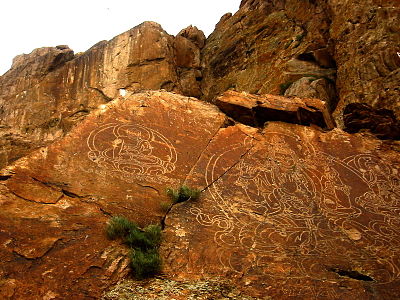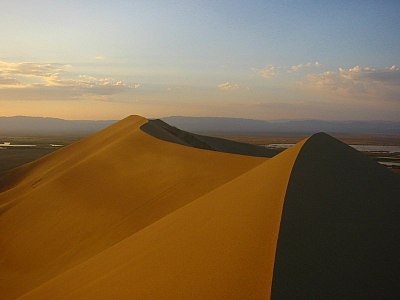Ili (river)
| Ili | |
|---|---|
 Ili River | |
 Map of the Lake Balkhash drainage basin showing the Ili River and its tributaries | |
| Location | |
| Country | Kazakhstan and China |
| Physical characteristics | |
| Source | |
| • location | Tekes and Künes rivers |
| • elevation | Tian Shan |
| Mouth | |
• location | Lake Balkhash |
| Length | 1,439 km (894 mi) |
| Basin size | 140,000 km2 (54,000 sq mi) |
| Discharge | |
| • average | 480 m3/s (17,000 cu ft/s) |
| Official name | Ili River Delta and South Lake Balkhash |
| Designated | 1 January 2012 |
| Reference no. | 2020[1] |
The Ili (
It is 1,439 kilometres (894 mi) long (including its source river the Tekes),[2] 815 kilometres (506 mi) of which is in Kazakhstan. The river originates from the Tekes and Künes rivers in Eastern Tian Shan. The Ili drains the basin between the Tian Shan and the Borohoro Mountains. Flowing into Lake Balkhash, the Ili forms a large delta with vast wetland regions of lakes, marshes and vegetation.[3][4]
Etymology
Mentions of Ili river can be traced back to the Mahmud al-Kashgari's dictionary of Turkic languages, the Dīwānu l-Luġat al-Turk (written in 1072–74). In the book, the author defines it in the following way: "Ili, the name of a river. Turkic tribes of Yaghma, Tokhsi and Chiglig live on its banks. Turkish countries regard the river as their Jayhoun (Amu Darya)."[5] The name possibly originated from Uyghur word Il, meaning hook, resembling the river's geographical shape.[6]
Chinese region

The upper Ili Valley is separated from the
Presently, the region forms part of Xinjiang's
There are at least two dams on the Ili's tributary, the Kash River (喀什河), in Nilka County, at 43°51′40″N 82°50′52″E / 43.86111°N 82.84778°E and 43°51′14″N 82°48′08″E / 43.85389°N 82.80222°E. At least two dams have been constructed on the Ili's left tributary, the Tekes River, and the Qiapuqihai Hydropower Station (恰甫其海水电站) in
Kazakh region

The Ili is the main watercourse of the
The
The Tamgaly-Tas, a protected site that comprises
Ili Delta

The Ili River flows into the southeastern edge of
The Government of Kazakhstan plans to join the three sanctuaries Balkash, Karoy and Kukan (situated in the delta) into one National Park.[8] Until 1948, the delta was a refuge of the extinct Caspian tiger. An introduction of the Siberian tiger to the delta has been proposed on account that it is a genetically close relative of the Caspian tiger. A large population of wild boar, the main prey base of the Caspian tiger, can be still found in the delta. There is also a small population of roe deer. In the drier steppes to the south of the delta live saiga antelopes and goitered gazelles.
Reintroduction of the
Historical connections
The
The amount of precipitation in summer reaches 150-250 cubic meters.
Fishing
On the river, the most popular type of fishing is fishing of catfish, one of the largest aquatic predators, which may reach 5 meters in length and weigh up to 300 kg. Smaller specimens are usually within 50–100 kg.
Gallery
-
Ili River
-
Buddhist rock drawings at Ili River
-
Ili River
-
The "singing dune" at Altyn-Emel National Park
Tributaries
The main tributaries of the Ili are, from source to mouth:[2]
References
- ^ a b "Ili River Delta and South Lake Balkhash". Ramsar Sites Information Service. Retrieved 25 April 2018.
- ^ a b Или, Great Soviet Encyclopedia
- ^ Ili River
- ^ Ili river Kazakhstan
- ^ Mahmud Kashgari, Dīwānu l-Luġat al-Turk (En: Compendium of the languages of the Turks). Vol I, p124. 1072–1074
- ^ Adil Arup, Ili atalghusi heqqide (Etymology of Ili), Journal of Ili Darya, in Uyghur, 2007
- S2CID 128565175.
- ^ Masha Vinokurova (Press officer), Olga Pereladova (Head of the WWF Central Asia Programme): Kazakhstan names large inland delta Archived 2017-04-01 at the Wayback Machine, WWF Information February, 2012
- ^ Hartmut Jungius (2010). Feasibility Study on the Possible Restoration of the Caspian Tiger in Central Asia Archived 2011-11-17 at the Wayback Machine. WWF
- ^ Zuev Yu.L., The strongest tribe, Almaty, 2004, pp. 55–6,
- ]
- Или, река Семиречинской области (The Ili River), in Brockhaus and Efron Encyclopedic Dictionary




